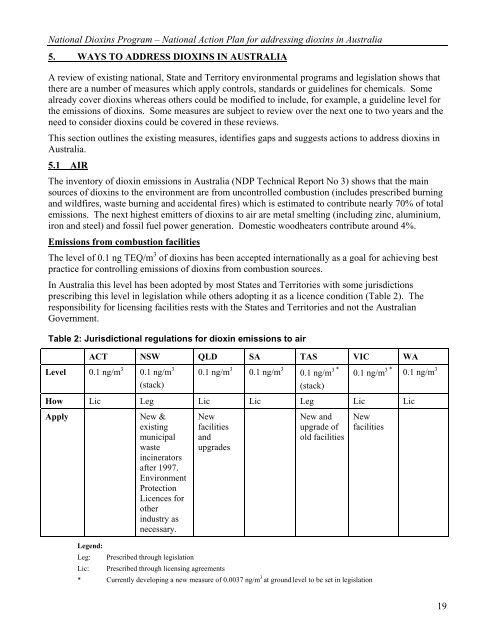National Action Plan for Addressing Dioxins in Australia
National Action Plan for Addressing Dioxins in Australia
National Action Plan for Addressing Dioxins in Australia
- No tags were found...
You also want an ePaper? Increase the reach of your titles
YUMPU automatically turns print PDFs into web optimized ePapers that Google loves.
<strong>National</strong> <strong>Diox<strong>in</strong>s</strong> Program – <strong>National</strong> <strong>Action</strong> <strong>Plan</strong> <strong>for</strong> address<strong>in</strong>g diox<strong>in</strong>s <strong>in</strong> <strong>Australia</strong>5. WAYS TO ADDRESS DIOXINS IN AUSTRALIAA review of exist<strong>in</strong>g national, State and Territory environmental programs and legislation shows thatthere are a number of measures which apply controls, standards or guidel<strong>in</strong>es <strong>for</strong> chemicals. Somealready cover diox<strong>in</strong>s whereas others could be modified to <strong>in</strong>clude, <strong>for</strong> example, a guidel<strong>in</strong>e level <strong>for</strong>the emissions of diox<strong>in</strong>s. Some measures are subject to review over the next one to two years and theneed to consider diox<strong>in</strong>s could be covered <strong>in</strong> these reviews.This section outl<strong>in</strong>es the exist<strong>in</strong>g measures, identifies gaps and suggests actions to address diox<strong>in</strong>s <strong>in</strong><strong>Australia</strong>.5.1 AIRThe <strong>in</strong>ventory of diox<strong>in</strong> emissions <strong>in</strong> <strong>Australia</strong> (NDP Technical Report No 3) shows that the ma<strong>in</strong>sources of diox<strong>in</strong>s to the environment are from uncontrolled combustion (<strong>in</strong>cludes prescribed burn<strong>in</strong>gand wildfires, waste burn<strong>in</strong>g and accidental fires) which is estimated to contribute nearly 70% of totalemissions. The next highest emitters of diox<strong>in</strong>s to air are metal smelt<strong>in</strong>g (<strong>in</strong>clud<strong>in</strong>g z<strong>in</strong>c, alum<strong>in</strong>ium,iron and steel) and fossil fuel power generation. Domestic woodheaters contribute around 4%.Emissions from combustion facilitiesThe level of 0.1 ng TEQ/m 3 of diox<strong>in</strong>s has been accepted <strong>in</strong>ternationally as a goal <strong>for</strong> achiev<strong>in</strong>g bestpractice <strong>for</strong> controll<strong>in</strong>g emissions of diox<strong>in</strong>s from combustion sources.In <strong>Australia</strong> this level has been adopted by most States and Territories with some jurisdictionsprescrib<strong>in</strong>g this level <strong>in</strong> legislation while others adopt<strong>in</strong>g it as a licence condition (Table 2). Theresponsibility <strong>for</strong> licens<strong>in</strong>g facilities rests with the States and Territories and not the <strong>Australia</strong>nGovernment.Table 2: Jurisdictional regulations <strong>for</strong> diox<strong>in</strong> emissions to airACT NSW QLD SA TAS VIC WALevel 0.1 ng/m 3 0.1 ng/m 3(stack)0.1 ng/m 3 0.1 ng/m 3 0.1 ng/m 3 *(stack)0.1 ng/m 3 * 0.1 ng/m 3How Lic Leg Lic Lic Leg Lic LicApplyNew &exist<strong>in</strong>gmunicipalwaste<strong>in</strong>c<strong>in</strong>eratorsafter 1997.EnvironmentProtectionLicences <strong>for</strong>other<strong>in</strong>dustry asnecessary.NewfacilitiesandupgradesNew andupgrade ofold facilitiesNewfacilitiesLegend:Leg: Prescribed through legislationLic: Prescribed through licens<strong>in</strong>g agreements* Currently develop<strong>in</strong>g a new measure of 0.0037 ng/m 3 at ground level to be set <strong>in</strong> legislation19
















